2001 MERCEDES-BENZ CLK320 parking brake
[x] Cancel search: parking brakePage 230 of 325

227 Malfunction and indicator lamps
Te ch n ica l
data Instruments
and controlsOperation DrivingInstrument
cluster displayPractical hints Car care Index Brake warning lamp
Except Canada
Canada only
When the brake warning lamp and message appear
while the engine is running, this means:
•there is insufficient brake fluid in the reservoir
(engine running and parking brake released), or
•the parking brake is set (engine running).Note:
If you find that the minimum mark on the brake fluid
reservoir is reached, have the brake system checked for
brake pad thickness and leaks.
BRAKE
Wa r n i n g !
Driving with the brake warning lamp illuminated
can result in an accident. Have your brake system
checked immediately if the brake warning lamp
stays on. Don’t add brake fluid before checking the
brake system. Overfilling the brake fluid reservoir
can result in spilling brake fluid on hot engine
parts and the brake fluid catching fire. You can be
seriously burned.
Page 239 of 325

236 Malfunction and warning messages
Te ch n ica l
data Instruments
and controlsOperation DrivingInstrument
cluster displayPractical hints Car care Index
PA R K I N G B R A K E
Parking brake, see page 200.ENGINE FAN
1 The cooling fan for the coolant is faulty.
Observe coolant temperature gauge while driving, see page 86. Line 1 Line 2
PARKING BRAKE RELEASE BRAKE!Line 1 Line 2
ENGINE FAN VISIT WORKSHOP!
1
Page 242 of 325
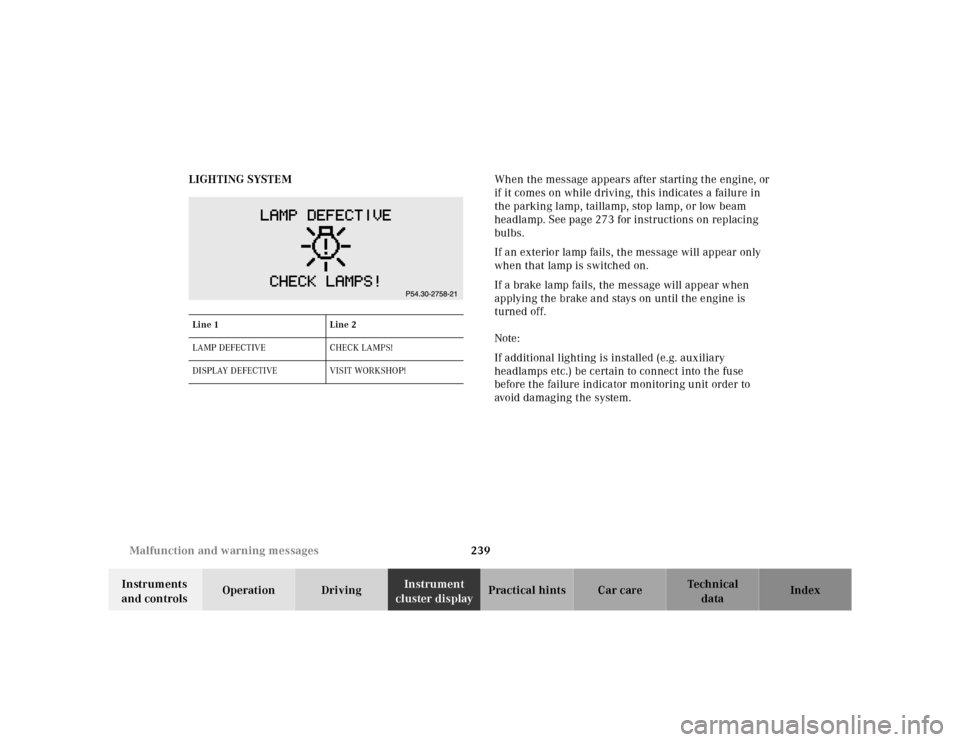
239 Malfunction and warning messages
Te ch n ica l
data Instruments
and controlsOperation DrivingInstrument
cluster displayPractical hints Car care Index LIGHTING SYSTEMWhen the message appears after starting the engine, or
if it comes on while driving, this indicates a failure in
the parking lamp, taillamp, stop lamp, or low beam
headlamp. See page 273 for instructions on replacing
bulbs.
If an exterior lamp fails, the message will appear only
when that lamp is switched on.
If a brake lamp fails, the message will appear when
applying the brake and stays on until the engine is
turned off.
Note:
If additional lighting is installed (e.g. auxiliary
headlamps etc.) be certain to connect into the fuse
before the failure indicator monitoring unit order to
avoid damaging the system.
Line 1 Line 2
LAMP DEFECTIVE CHECK LAMPS!
DISPLAY DEFECTIVE VISIT WORKSHOP!
Page 259 of 325
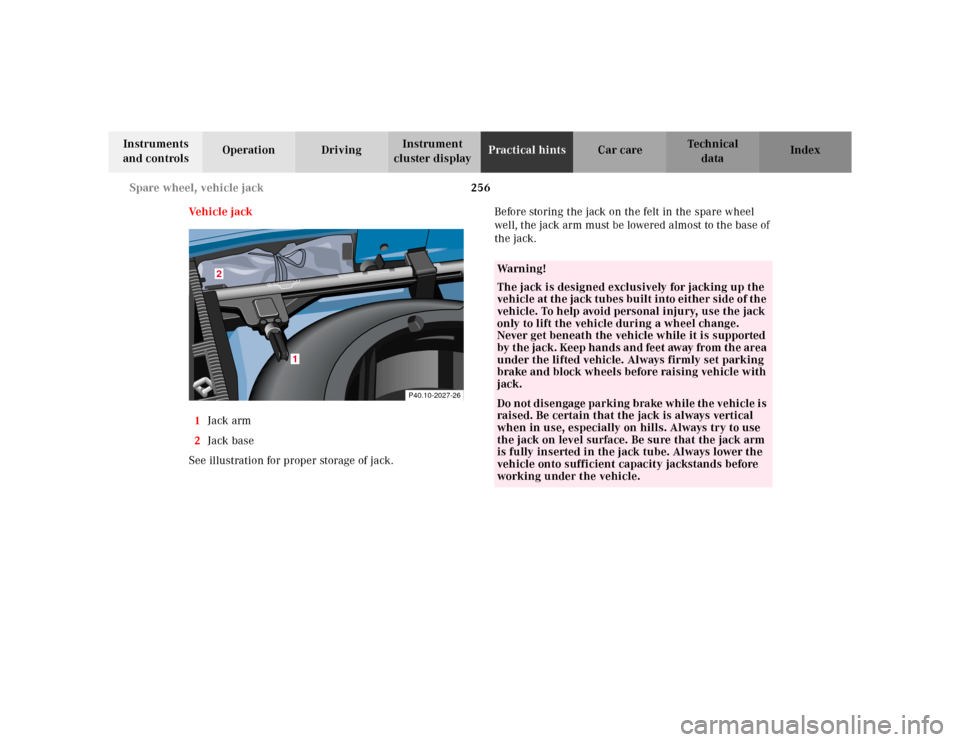
256 Spare wheel, vehicle jack
Te ch n ica l
data Instruments
and controlsOperation DrivingInstrument
cluster displayPractical hintsCar care Index
Ve h i c l e j a c k
1Jack arm
2Jack base
See illustration for proper storage of jack.Before storing the jack on the felt in the spare wheel
well, the jack arm must be lowered almost to the base of
the jack.
1
2
P40.10-2027-26
Wa r n i n g !
The jack is designed exclusively for jacking up the
vehicle at the jack tubes built into either side of the
vehicle. To help avoid personal injury, use the jack
only to lift the vehicle during a wheel change.
Never get beneath the vehicle while it is supported
by the jack. Keep hands and feet away from the area
under the lifted vehicle. Always firmly set parking
brake and block wheels before raising vehicle with
jack.Do not disengage parking brake while the vehicle is
raised. Be certain that the jack is always vertical
when in use, especially on hills. Always try to use
the jack on level surface. Be sure that the jack arm
is fully inserted in the jack tube. Always lower the
vehicle onto sufficient capacity jackstands before
working under the vehicle.
Page 263 of 325
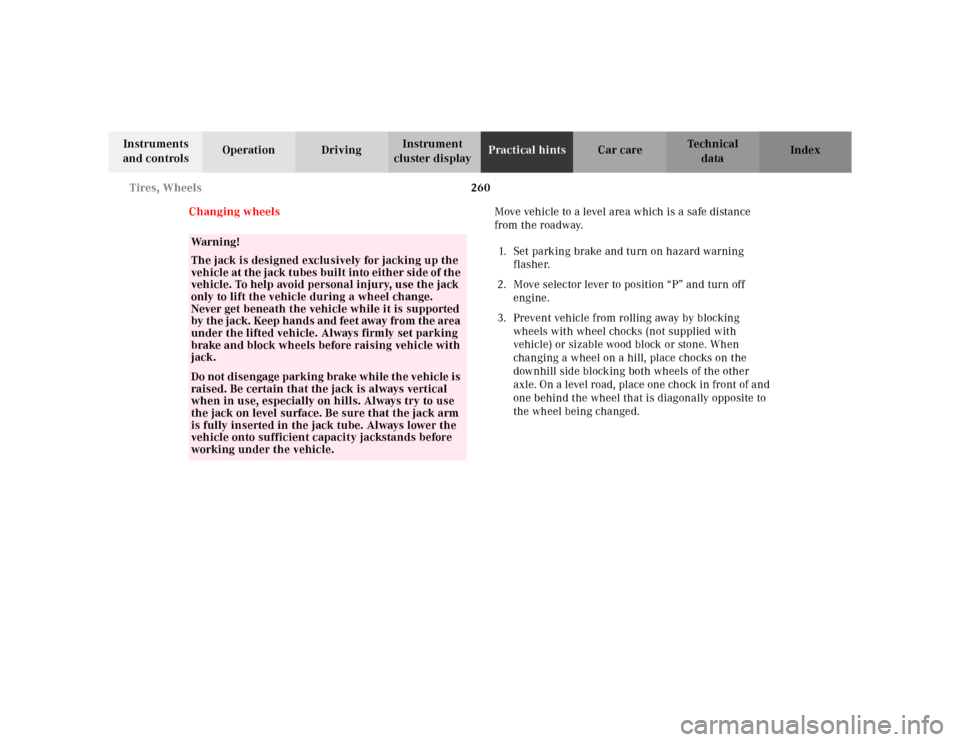
260 Tires, Wheels
Te ch n ica l
data Instruments
and controlsOperation DrivingInstrument
cluster displayPractical hintsCar care Index
Changing wheelsMove vehicle to a level area which is a safe distance
from the roadway.
1. Set parking brake and turn on hazard warning
flasher.
2. Move selector lever to position “P” and turn off
engine.
3. Prevent vehicle from rolling away by blocking
wheels with wheel chocks (not supplied with
vehicle) or sizable wood block or stone. When
changing a wheel on a hill, place chocks on the
downhill side blocking both wheels of the other
axle. On a level road, place one chock in front of and
one behind the wheel that is diagonally opposite to
the wheel being changed.
Wa r n i n g !
The jack is designed exclusively for jacking up the
vehicle at the jack tubes built into either side of the
vehicle. To help avoid personal injury, use the jack
only to lift the vehicle during a wheel change.
Never get beneath the vehicle while it is supported
by the jack. Keep hands and feet away from the area
under the lifted vehicle. Always firmly set parking
brake and block wheels before raising vehicle with
jack.Do not disengage parking brake while the vehicle is
raised. Be certain that the jack is always vertical
when in use, especially on hills. Always try to use
the jack on level surface. Be sure that the jack arm
is fully inserted in the jack tube. Always lower the
vehicle onto sufficient capacity jackstands before
working under the vehicle.
Page 272 of 325
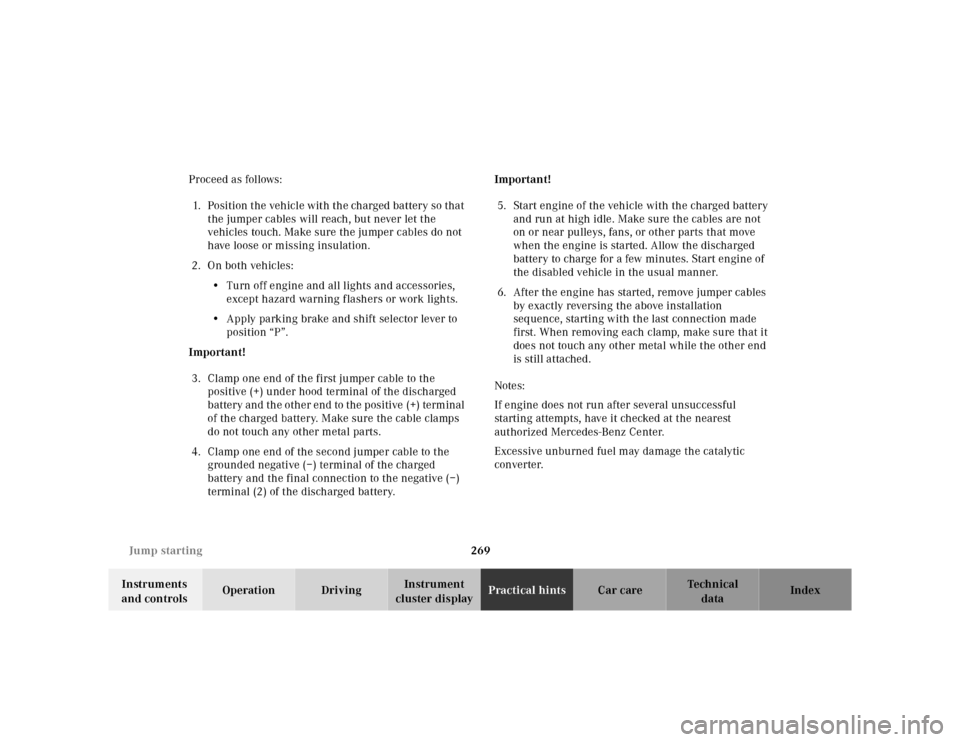
269 Jump starting
Te ch n ica l
data Instruments
and controlsOperation DrivingInstrument
cluster displayPractical hintsCar care Index Proceed as follows:
1. Position the vehicle with the charged battery so that
the jumper cables will reach, but never let the
vehicles touch. Make sure the jumper cables do not
have loose or missing insulation.
2. On both vehicles:
•Turn off engine and all lights and accessories,
except hazard warning flashers or work lights.
•Apply parking brake and shift selector lever to
position “P”.
Important!
3. Clamp one end of the first jumper cable to the
positive (+) under hood terminal of the discharged
battery and the other end to the positive (+) terminal
of the charged battery. Make sure the cable clamps
do not touch any other metal parts.
4. Clamp one end of the second jumper cable to the
grounded negative (–) terminal of the charged
battery and the final connection to the negative (–)
terminal (2) of the discharged battery.Important!
5. Start engine of the vehicle with the charged battery
and run at high idle. Make sure the cables are not
on or near pulleys, fans, or other parts that move
when the engine is started. Allow the discharged
battery to charge for a few minutes. Start engine of
the disabled vehicle in the usual manner.
6. After the engine has started, remove jumper cables
by exactly reversing the above installation
sequence, starting with the last connection made
first. When removing each clamp, make sure that it
does not touch any other metal while the other end
is still attached.
Notes:
If engine does not run after several unsuccessful
starting attempts, have it checked at the nearest
authorized Mercedes-Benz Center.
Excessive unburned fuel may damage the catalytic
converter.
Page 318 of 325
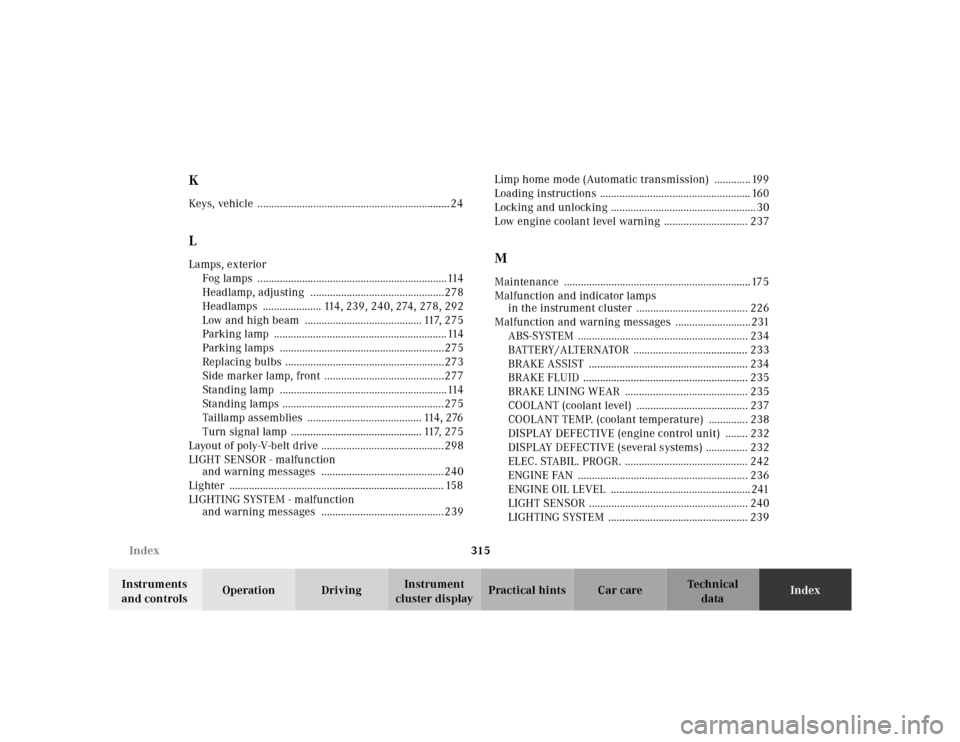
315 Index
Te ch n ica l
data Instruments
and controlsOperation DrivingInstrument
cluster displayPractical hints Car careIndex
KKeys, vehicle ..................................................................... 24LLamps, exterior
Fog lamps ....................................................................114
Headlamp, adjusting ................................................278
Headlamps ..................... 114, 239, 240, 274, 278, 292
Low and high beam .......................................... 117, 275
Parking lamp ..............................................................114
Parking lamps ...........................................................275
Replacing bulbs .........................................................273
Side marker lamp, front ...........................................277
Standing lamp ............................................................114
Standing lamps ..........................................................275
Taillamp assemblies ......................................... 114, 276
Turn signal lamp ............................................... 117, 275
Layout of poly-V-belt drive ............................................298
LIGHT SENSOR - malfunction
and warning messages ............................................240
Lighter ............................................................................. 158
LIGHTING SYSTEM - malfunction
and warning messages ............................................239Limp home mode (Automatic transmission) ............. 199
Loading instructions ...................................................... 160
Locking and unlocking .................................................... 30
Low engine coolant level warning .............................. 237
MMaintenance ...................................................................175
Malfunction and indicator lamps
in the instrument cluster ........................................ 226
Malfunction and warning messages ...........................231
ABS-SYSTEM ............................................................. 234
BATTERY/ALTERNATOR ......................................... 233
BRAKE ASSIST ......................................................... 234
BRAKE FLUID ........................................................... 235
BRAKE LINING WEAR ............................................ 235
COOLANT (coolant level) ........................................ 237
COOLANT TEMP. (coolant temperature) .............. 238
DISPLAY DEFECTIVE (engine control unit) ........ 232
DISPLAY DEFECTIVE (several systems) ............... 232
ELEC. STABIL. PROGR. ............................................ 242
ENGINE FAN ............................................................. 236
ENGINE OIL LEVEL .................................................. 241
LIGHT SENSOR ......................................................... 240
LIGHTING SYSTEM .................................................. 239
Page 319 of 325
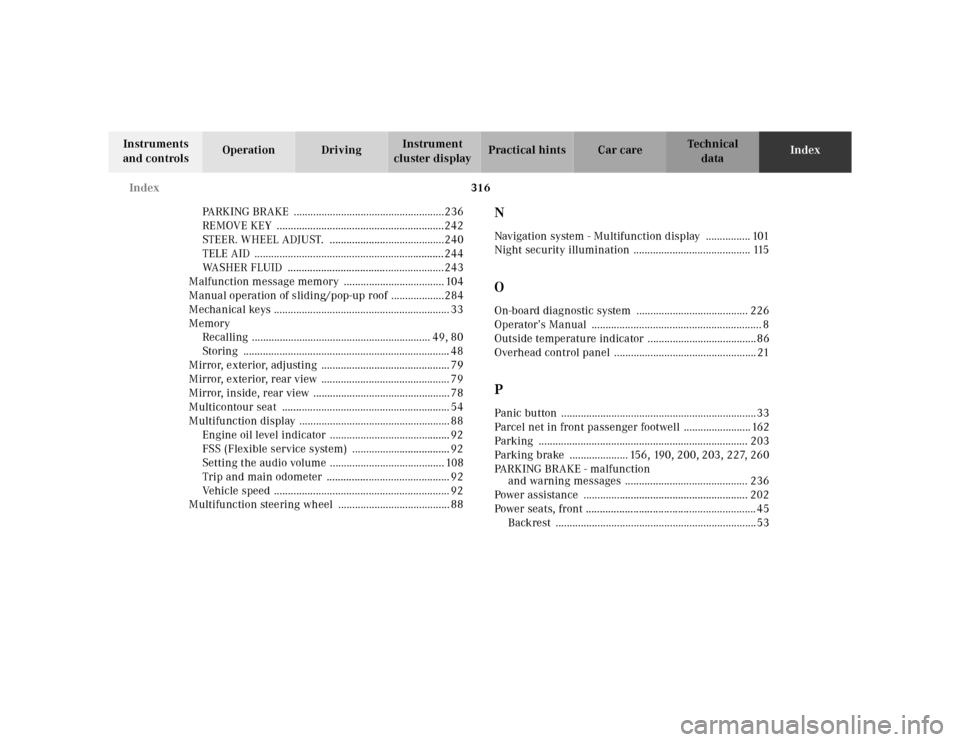
316 Index
Te ch n ica l
data Instruments
and controlsOperation DrivingInstrument
cluster displayPractical hints Car careIndex
PARKING BRAKE ......................................................236
REMOVE KEY ............................................................242
STEER. WHEEL ADJUST. .........................................240
TELE AID ....................................................................244
WASHER FLUID ........................................................243
Malfunction message memory .................................... 104
Manual operation of sliding/pop-up roof ...................284
Mechanical keys ............................................................... 33
Memory
Recalling ................................................................ 49, 80
Storing .......................................................................... 48
Mirror, exterior, adjusting .............................................. 79
Mirror, exterior, rear view .............................................. 79
Mirror, inside, rear view ................................................. 78
Multicontour seat ............................................................ 54
Multifunction display ...................................................... 88
Engine oil level indicator ........................................... 92
FSS (Flexible service system) ................................... 92
Setting the audio volume ......................................... 108
Trip and main odometer ............................................ 92
Vehicle speed ............................................................... 92
Multifunction steering wheel ........................................ 88
NNavigation system - Multifunction display ................ 101
Night security illumination .......................................... 115OOn-board diagnostic system ........................................ 226
Operator’s Manual ............................................................. 8
Outside temperature indicator .......................................86
Overhead control panel ................................................... 21PPanic button ......................................................................33
Parcel net in front passenger footwell ........................ 162
Parking ........................................................................... 203
Parking brake ..................... 156, 190, 200, 203, 227, 260
PA R K I N G B R A K E - m a l f u n c t i o n
and warning messages ............................................ 236
Power assistance ........................................................... 202
Power seats, front ............................................................. 45
Backrest ........................................................................53